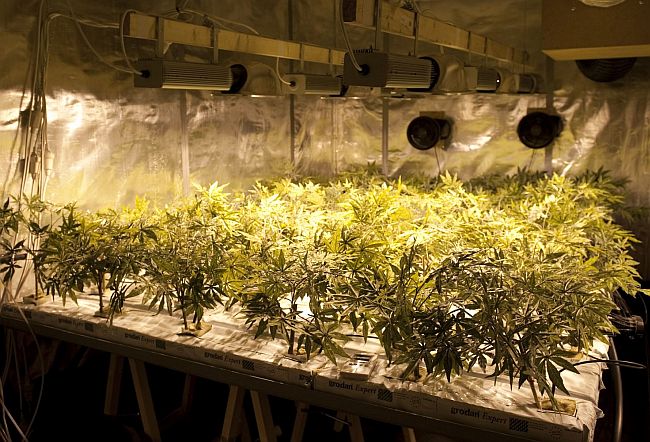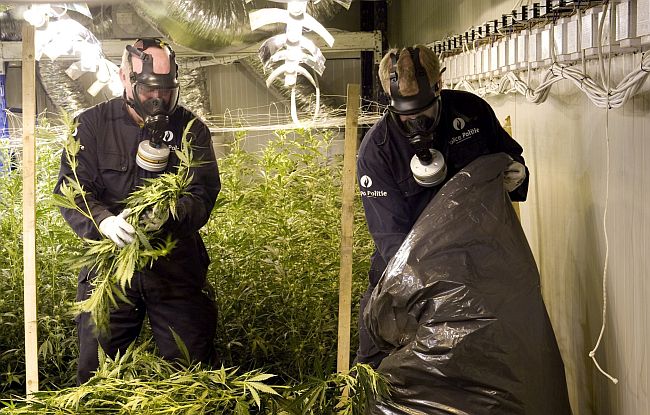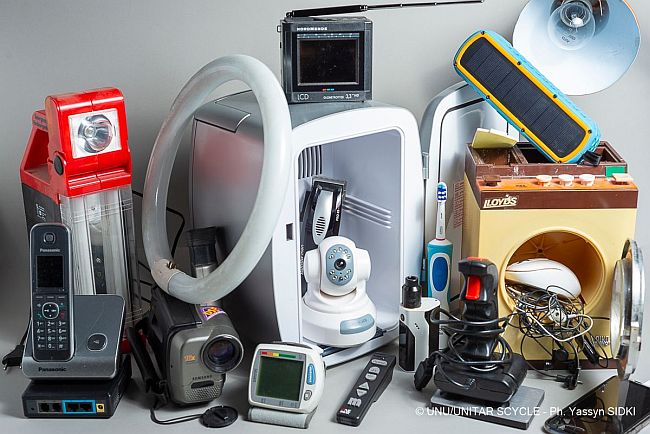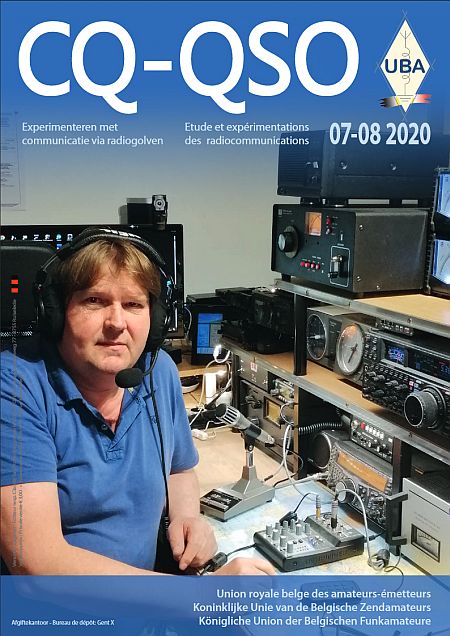
Actueel - Detail
HAM Radio online
12-06-2020
 Notre association sœur allemande DARC a prévu maintenant d'offrir un programme de remplacement en ligne. Du vendredi 26 au dimanche 28 juin y compris, vous pourrez participer virtuellement via YouTube à un large éventail de conférences, de présentations et de séances d'informations. Vous pouvez voir le programme complet ici.
Notre association sœur allemande DARC a prévu maintenant d'offrir un programme de remplacement en ligne. Du vendredi 26 au dimanche 28 juin y compris, vous pourrez participer virtuellement via YouTube à un large éventail de conférences, de présentations et de séances d'informations. Vous pouvez voir le programme complet ici.
 Notre association sœur allemande DARC a prévu maintenant d'offrir un programme de remplacement en ligne. Du vendredi 26 au dimanche 28 juin y compris, vous pourrez participer virtuellement via YouTube à un large éventail de conférences, de présentations et de séances d'informations. Vous pouvez voir le programme complet ici.
Notre association sœur allemande DARC a prévu maintenant d'offrir un programme de remplacement en ligne. Du vendredi 26 au dimanche 28 juin y compris, vous pourrez participer virtuellement via YouTube à un large éventail de conférences, de présentations et de séances d'informations. Vous pouvez voir le programme complet ici.
BIPT examens
16-06-2020
 Het BIPT laat weten dat het de radioamateur examens, zowel basisvergunning als HAREC, hervat heeft.
Het BIPT laat weten dat het de radioamateur examens, zowel basisvergunning als HAREC, hervat heeft.
Momenteel kan men enkel inschrijven per e-mail aan examen [at] bipt [dot] be. Vermeld hierbij aan welk examen (bassivergunning of HAREC) je wenst deel te nemen.
De kandidaten moeten zelf een mondmasker en persoonlijk schrijfgerief voorzien. Verdere regels die dienen gevolgd te worden, worden na inschrijven van de kandidaat meegedeeld.
Het examen wordt voorlopig ook niet meer op computer maar schriftelijk (op papier) afgenomen.
 Het BIPT laat weten dat het de radioamateur examens, zowel basisvergunning als HAREC, hervat heeft.
Het BIPT laat weten dat het de radioamateur examens, zowel basisvergunning als HAREC, hervat heeft.Momenteel kan men enkel inschrijven per e-mail aan examen [at] bipt [dot] be. Vermeld hierbij aan welk examen (bassivergunning of HAREC) je wenst deel te nemen.
De kandidaten moeten zelf een mondmasker en persoonlijk schrijfgerief voorzien. Verdere regels die dienen gevolgd te worden, worden na inschrijven van de kandidaat meegedeeld.
Het examen wordt voorlopig ook niet meer op computer maar schriftelijk (op papier) afgenomen.
Opleiding basisvergunning in tijden van corona
16-06-2020
 Nu de corona maatregelen versoepeld worden wensen een aantal secties een opleiding voor de basisvergunning te geven of een afgebroken opleiding te hervatten.
Nu de corona maatregelen versoepeld worden wensen een aantal secties een opleiding voor de basisvergunning te geven of een afgebroken opleiding te hervatten.
Om deze opleidingen zo veilig mogelijk te laten verlopen heeft het BIPT op voorstel van de UBA toegestaan om de opleiding, met uitzondering van de punten 8e (bekwaamheid in het maken van radioverbindingen) en 8f (aansluiten van een zender/ontvanger) van het programma en de praktische proef, via afstandsonderwijs te geven, bijvoorbeeld lessen via een videoconferentie.
Het afstandsonderwijs dient zo gegeven te worden dat een interactie (vragen stellen) tussen de kandidaten en de lesgever mogelijk is.
Het spreekt vanzelf dat tijdens de praktijklessen (8e en 8f) en de praktische proef de nodige veiligheidsmaatregelen in acht genomen worden, zoals social distancing en het ontsmetten van de apparatuur.
De opleidingen moeten nog steeds tijdig aangekondigd worden (ten minste 1 maand op voorhand) door het daarvoor voorziene formulier op te sturen naar ON7YD(@uba.be). Bij het deel van de opleiding dat via afstandsonderwijs gebeurt vermeld je bij "plaats" de wijze waarop het afstandsonderwijs gegeven wordt.
Secties die een opleiding onderbroken door de corona crisis willen hervatten bezorgen eveneens het formulier met de aangepaste opleiding aan ON7YD.
 Nu de corona maatregelen versoepeld worden wensen een aantal secties een opleiding voor de basisvergunning te geven of een afgebroken opleiding te hervatten.
Nu de corona maatregelen versoepeld worden wensen een aantal secties een opleiding voor de basisvergunning te geven of een afgebroken opleiding te hervatten.Om deze opleidingen zo veilig mogelijk te laten verlopen heeft het BIPT op voorstel van de UBA toegestaan om de opleiding, met uitzondering van de punten 8e (bekwaamheid in het maken van radioverbindingen) en 8f (aansluiten van een zender/ontvanger) van het programma en de praktische proef, via afstandsonderwijs te geven, bijvoorbeeld lessen via een videoconferentie.
Het afstandsonderwijs dient zo gegeven te worden dat een interactie (vragen stellen) tussen de kandidaten en de lesgever mogelijk is.
Het spreekt vanzelf dat tijdens de praktijklessen (8e en 8f) en de praktische proef de nodige veiligheidsmaatregelen in acht genomen worden, zoals social distancing en het ontsmetten van de apparatuur.
De opleidingen moeten nog steeds tijdig aangekondigd worden (ten minste 1 maand op voorhand) door het daarvoor voorziene formulier op te sturen naar ON7YD(@uba.be). Bij het deel van de opleiding dat via afstandsonderwijs gebeurt vermeld je bij "plaats" de wijze waarop het afstandsonderwijs gegeven wordt.
Secties die een opleiding onderbroken door de corona crisis willen hervatten bezorgen eveneens het formulier met de aangepaste opleiding aan ON7YD.
Formation de base aux licences en période de Covid-19
16-06-2020
 Maintenant que les mesures Covid-19 sont assouplies, un certain nombre de sections souhaiteraient dispenser une formation pour la licence de base ou reprendre une formation suspendue.
Maintenant que les mesures Covid-19 sont assouplies, un certain nombre de sections souhaiteraient dispenser une formation pour la licence de base ou reprendre une formation suspendue.
Afin de garantir que ces formations se déroulent de la manière la plus sûre possible, l'IBPT, sur proposition de l'UBA, a autorisé la formation, à l'exception des points 8e (compétence pour établir des liaisons radio) et 8f (raccordement d'un émetteur / récepteur) du programme et donner le test pratique, par le biais de l'enseignement à distance, par exemple des leçons via une vidéoconférence.
L'enseignement à distance doit être dispensé de manière à permettre une interaction (poser des questions) entre les candidats et le formateur.
Il va de soi que lors des cours pratiques (8e et 8f) et du test pratique, les mesures de sécurité nécessaires seront prises, telles que la mise à distance sociale et la désinfection du matériel.
Les cours doivent encore être annoncés à temps (au moins 1 mois à l'avance) en envoyant le formulaire approprié à ON6TI (@uba.be). Pour la partie de la formation dispensée par l'enseignement à distance, vous devez indiquer sous "place" la manière dont l'enseignement à distance est dispensé. Les sections qui souhaitent reprendre une formation interrompue par la crise Covid-19 fourniront également le formulaire de formation adapté à ON6TI.
Traduction : ON1KSL
 Maintenant que les mesures Covid-19 sont assouplies, un certain nombre de sections souhaiteraient dispenser une formation pour la licence de base ou reprendre une formation suspendue.
Maintenant que les mesures Covid-19 sont assouplies, un certain nombre de sections souhaiteraient dispenser une formation pour la licence de base ou reprendre une formation suspendue.Afin de garantir que ces formations se déroulent de la manière la plus sûre possible, l'IBPT, sur proposition de l'UBA, a autorisé la formation, à l'exception des points 8e (compétence pour établir des liaisons radio) et 8f (raccordement d'un émetteur / récepteur) du programme et donner le test pratique, par le biais de l'enseignement à distance, par exemple des leçons via une vidéoconférence.
L'enseignement à distance doit être dispensé de manière à permettre une interaction (poser des questions) entre les candidats et le formateur.
Il va de soi que lors des cours pratiques (8e et 8f) et du test pratique, les mesures de sécurité nécessaires seront prises, telles que la mise à distance sociale et la désinfection du matériel.
Les cours doivent encore être annoncés à temps (au moins 1 mois à l'avance) en envoyant le formulaire approprié à ON6TI (@uba.be). Pour la partie de la formation dispensée par l'enseignement à distance, vous devez indiquer sous "place" la manière dont l'enseignement à distance est dispensé. Les sections qui souhaitent reprendre une formation interrompue par la crise Covid-19 fourniront également le formulaire de formation adapté à ON6TI.
Traduction : ON1KSL
Examens IBPT
16-06-2020
 L'IBPT annonce qu'il a repris les examens de radio-amateur, aussi bien la licence de base que l’HAREC.
L'IBPT annonce qu'il a repris les examens de radio-amateur, aussi bien la licence de base que l’HAREC.
Momentanément, vous ne pouvez vous inscrire que par e-mail à examen [at] bipt [dot] be. Veuillez indiquer à quel examen (licence de base ou HAREC) vous souhaitez participer.
Les candidats doivent fournir eux-mêmes leur masque buccal et du matériel d'écriture personnel.
Les autres règles à suivre seront communiquées après l'inscription du candidat. Pour l'instant, l'examen ne se déroulera plus sur ordinateur, mais par écrit (sur papier).
Traduction: ON1KSL
 L'IBPT annonce qu'il a repris les examens de radio-amateur, aussi bien la licence de base que l’HAREC.
L'IBPT annonce qu'il a repris les examens de radio-amateur, aussi bien la licence de base que l’HAREC. Momentanément, vous ne pouvez vous inscrire que par e-mail à examen [at] bipt [dot] be. Veuillez indiquer à quel examen (licence de base ou HAREC) vous souhaitez participer.
Les candidats doivent fournir eux-mêmes leur masque buccal et du matériel d'écriture personnel.
Les autres règles à suivre seront communiquées après l'inscription du candidat. Pour l'instant, l'examen ne se déroulera plus sur ordinateur, mais par écrit (sur papier).
Traduction: ON1KSL
De CQ-QSO van juli-augustus 2020 is online
30-06-2020
De nieuwe CQ-QSO (07-08/2020) is online.
Een rijk gevulde editie met boordevol informatie!
Uit de inhoudsopgave:
UBA News
Technical Info
VHF
HF
Varia
Enjoy!
Een rijk gevulde editie met boordevol informatie!
Uit de inhoudsopgave:
UBA News
- Voorwoord
- Koninklijke Unie van de Belgische Zendamateurs vzw – Statutaire Algemene Ledenvergadering – zaterdag 5 september 2020
- Lijst van de DM en CM 2020
- De geschiedenis van de Belgische radioamateurs in het algemeen en van de Waalse in het bijzonder...
Technical Info
- Arduino voor Radioamateurs (deel 8)
- Morse leren?
- Een ouderwetse bel
- ’Case Study’ – Verticale antenne voor de 40m-band
- De definitieve versie van WSJT-X 2.2.0 rc2 is thans WSJT-X 2.2.0 geworden
- Hoe uw versterker aansturen vanuit de Kenwood TS-890
- Nee, D-STAR is niet dood
- QCX – Single band QRP CW transceiver
VHF
- De ’W-VL Vriendenronde’
- Permanente toegang tot de 6m band in Duitsland
HF
- Contest Calendar
- OP0HQ hits the waves with The Belgian Radio Red Devils
- PJ2T: Contesting Caribbean Style
- Het International Lighthouse Lightship Weekend heeft dit jaar plaats op 22 en 23 augustus
Varia
- Radioamateurs en wiettelers
- De UBA-secties activeerden meerdere STAYHOME stations
Enjoy!
Le CQ-QSO de juillet-août 2020 est en ligne
30-06-2020
Le nouveau CQ-QSO (07-08/2020) est en ligne...
Une édition richement remplie avec beaucoup d'informations !
Sommaire :
UBA News
Technical Info
VHF
HF
Varia
Enjoy!
Une édition richement remplie avec beaucoup d'informations !
Sommaire :
UBA News
- Avant-propos
- Union royale belge des amateurs-émetteurs asbl Assemblée Générale Statutaire des Membres samedi 5 septembre 2020
- Liste des DM et CM 2020
- Histoires des radioamateurs belges en général et wallons en particulier
Technical Info
- Arduino pour les Radioamateurs (8ème partie)
- Apprendre le Morse ?
- Une sonnette à l’ancienne
- ’Case Study’ – Antenne verticale pour le 40m
- La version finale de WSJT-X 2.2.0 rc2 se nomme maintenant WSJT-X 2.2.0
- Comment contrôler votre amplificateur à partir du Kenwood TS-890
- Non, le D-STAR n’est pas mort
- QCX – Single band QRP CW transceiver
VHF
- Le ’W-VL Vriendenronde’
- Accès permanent à la bande des 6 mètres en Allemagne
HF
- Contest Calendar
- OP0HQ hits the waves with The Belgian Radio Red Devils
- PJ2T : Contesting Caribbean Style
- Cette année, l’International Lighthouse Lightship Weekend se déroule les 22 et 23 août
Varia
- Radio-amateurs et cultivateurs de cannabis
- Les sections de l’UBA ont activé plusieurs stations STAYHOME
Enjoy!
Radio amateurs and cannabis growers
30-06-2020
Until a few years ago, high-pressure grow lights were used for this purpose.
The power consumption of these lights was very high, they were expensive and they lasted barely 5,000 to a maximum of 10,000 hours before they failed. They were the first actual use of artificial light to stimulate growth of flowers and plants. Later on this method was cleverly applied for growing weed. To hide the massive power consumption, electricity was tapped before the electricity meter, all in all a risky business. The introduction of LED lighting significantly reduced power consumption and increased the lamps’ lifespan to values that are typically between 30,000 and 50,000 hours. As it happens, cannabis plants grow much better with specific LED grow lights or assimilation lighting than with sunlight. If it was previously possible to discover indoor plantations, this is now declining sharply with LED lighting.
And another phenomenon emerged. Radio amateurs with sophisticated antennas and equipment are being adversely affected in large numbers.

There was an adequate solution: the 252 solar panels in the area were switched off. A similar EMC problem occurs with the LED lighting in cannabis plantations.
If electromagnetic signals are disturbed, they have the right to file a complaint with the government. The appropriate government services will then try to locate the interference signals. Interferences first observed by radio amateurs are often accompanied by citizens’ complaints about problems with radio reception, remote controls or Wi-Fi. However, because of the high visibility of radio amateurs' antennas, they are often wrongly accused as the cause of the interference by ignorant citizens. Specialised investigation then usually leads to the discovery of all kinds of inexpensive unapproved electronic items, or to the discovery of cannabis plantations.
Ultimately, living in the vicinity of a radio amateur is not a bad idea. They are the first to discover any irregularities related to electromagnetic signals and they have every interest in this being resolved as quickly as possible.

Freddy De Schuiteneer -ON3FDS
Courtesy of VERON and the Federal Police
Photos and copyright: Federal Police, Lavinia Wouters and Freddy De Schuiteneer
Daylight is replaced by artificial light
Plants and flowers need light energy to grow through photosynthesis. Crops that are sensitive to temperature are grown in a greenhouse with natural sunlight. Artificial light can partially or completely replace sunlight, and can even be of a much better quality, on condition that certain lighting quality rules are observed.Until a few years ago, high-pressure grow lights were used for this purpose.
The power consumption of these lights was very high, they were expensive and they lasted barely 5,000 to a maximum of 10,000 hours before they failed. They were the first actual use of artificial light to stimulate growth of flowers and plants. Later on this method was cleverly applied for growing weed. To hide the massive power consumption, electricity was tapped before the electricity meter, all in all a risky business. The introduction of LED lighting significantly reduced power consumption and increased the lamps’ lifespan to values that are typically between 30,000 and 50,000 hours. As it happens, cannabis plants grow much better with specific LED grow lights or assimilation lighting than with sunlight. If it was previously possible to discover indoor plantations, this is now declining sharply with LED lighting.
And another phenomenon emerged. Radio amateurs with sophisticated antennas and equipment are being adversely affected in large numbers.

LED lighting and electromagnetic interference
Light is partly a wave. The speed of light in a vacuum environment is equal to the speed of the electromagnetic waves. Many LED grow lights disturb the electromagnetic waves. Not only the HF bands but also the aviation bands and VHF, both with analogue and digital equipment. Interference can occur with electromagnetic waves, either constructive interference when waves are in phase, or destructive interference when waves counteract, neutralising each other. Much of the LED lighting used in illegal plantations became a real source of interference. This kind of LED lighting usually does not meet the requirements with regard to EMC or Electromagnetic Compatibility.The explorers of the frequency spectrum
Radio amateurs are the true explorers of the frequency spectrum. Using sophisticated antenna systems and sensitive radio equipment, they try to capture as many electromagnetic signals as possible. By contrast, they try to reach other radio amateurs located as distant as possible with as little power (expressed in watts or milliwatts) as possible. All of this within the legal framework for reception and broadcast. The number of interferences is increasing. Even if the source of the interference is a little further away, they are affected, often caused by the assimilation lighting of the LED lights.The problem with EMC
In late May 2019, Ivanka Trump and Queen Maxima visited The Hague. Police officers encountered difficulties as they were exploring the area beforehand. Wireless connections were being seriously disturbed or had even become impossible. The investigation services revealed that the problem was caused by the inverters converting the direct current output of solar panels into alternating current on the commercial grid. Many inverters are not compatible with European EMC rules. The inverters were sending interference signals, with the wiring acting as an antenna.There was an adequate solution: the 252 solar panels in the area were switched off. A similar EMC problem occurs with the LED lighting in cannabis plantations.
Radio amateurs are not police officers
It goes without saying that radio amateurs are not detectives searching for cannabis growers. They only want to pursue a hobby activity. To do so, they invest money and they pay taxes to the government every year.If electromagnetic signals are disturbed, they have the right to file a complaint with the government. The appropriate government services will then try to locate the interference signals. Interferences first observed by radio amateurs are often accompanied by citizens’ complaints about problems with radio reception, remote controls or Wi-Fi. However, because of the high visibility of radio amateurs' antennas, they are often wrongly accused as the cause of the interference by ignorant citizens. Specialised investigation then usually leads to the discovery of all kinds of inexpensive unapproved electronic items, or to the discovery of cannabis plantations.
Ultimately, living in the vicinity of a radio amateur is not a bad idea. They are the first to discover any irregularities related to electromagnetic signals and they have every interest in this being resolved as quickly as possible.

Freddy De Schuiteneer -ON3FDS
Courtesy of VERON and the Federal Police
Photos and copyright: Federal Police, Lavinia Wouters and Freddy De Schuiteneer
Verontrustende afvalstromen elektronische apparaten
03-07-2020
Verschillende internationale organisaties waaronder ook ITU en de World Health Organisation lanceerden vandaag een oproep tot bewustwording van de afvalproblematiek rond elektronische apparatuur.
Werkelijk gevaarlijk is het verontrustende gegeven dat 82,6 % op het gewoon stort of de doorsnee afvalberg terecht komt. Slechts 17,4 % van dit elektronisch afval wordt ingezameld en gerecycleerd. Elektronisch afval bevat verschillende toxische stoffen die een grote bedreiging vormen voor de gezondheid. Vooral kwik berokkent ernstige schade aan de hersenen en het centraal zenuwstelsel.
Ook aan radioamateurs wordt gevraagd om hun omgeving te sensibiliseren voor dit probleem. Radioamateurs zijn zich wel bewust van duurzaamheid, in het Engels “sustainability”. Zo zijn ze voortrekkers als het op het terug aanwenden van gebruikte batterijen en schijnbaar niet meer rendabele zonnepanelen aankomt.
Waarover later meer in uw tijdschrift CQ-QSO.

© UNU & ITU
Gigantische afvalberg bevat toxische stoffen
In 2019 werd in de wereld niet minder dan 53.600.000.000 kg elektronisch afval gedumpt. Om een idee te geven over de reële omvang van deze afvalberg kan het gewicht worden vergeleken met het gewicht van 350 cruiseschepen genre Queen Mary 2.Werkelijk gevaarlijk is het verontrustende gegeven dat 82,6 % op het gewoon stort of de doorsnee afvalberg terecht komt. Slechts 17,4 % van dit elektronisch afval wordt ingezameld en gerecycleerd. Elektronisch afval bevat verschillende toxische stoffen die een grote bedreiging vormen voor de gezondheid. Vooral kwik berokkent ernstige schade aan de hersenen en het centraal zenuwstelsel.
Elektronisch afval in de wereld
In 2019 belandde in Azië 24.900.000.000 kg elektronica op de afvalberg, in beide Amerika’s was dit 13.100.000.000 kg, in Europa 12.000.000.000 kg, in Afrika 2.900.000.000 kg en in Oceanië 700.000.000 kg. Elke aardbewoner zorgde in 2019 voor 7,3 kg elektronisch afval. Europa staat in 2019 op kop, met 16,2 kg elektronisch afval per inwoner.Ook aan radioamateurs wordt gevraagd om hun omgeving te sensibiliseren voor dit probleem. Radioamateurs zijn zich wel bewust van duurzaamheid, in het Engels “sustainability”. Zo zijn ze voortrekkers als het op het terug aanwenden van gebruikte batterijen en schijnbaar niet meer rendabele zonnepanelen aankomt.
Waarover later meer in uw tijdschrift CQ-QSO.

© UNU & ITU
L’inquiétant flux des déchets résultants des dispositifs électroniques
03-07-2020
Plusieures organisations internationales, dont l’ITU et l’OMS (Organisation Mondiale de la Santé), ont lancé aujourd’hui un appel à la sensibilisation aux problèmes des déchets liés aux équipements électroniques.
Le vrai danger et le plus inquiétant est que 82,6% de ces déchets sont simplement jetés au milieu de simples décharges d’ordures …
Seuls 17,4 % de ces déchets électroniques sont collectés et recyclés. Les déchets électroniques contiennent plusieurs substances toxiques qui constituent une menace majeure pour la santé. Le mercure en particulier cause de graves dommages au cerveau et au système nerveux central.
Chaque terrien a généré à lui seul quelques 7,3 kg de déchets électroniques en 2019. L’Europe est en tête en 2019 avec 16,2 kg de déchets électroniques par habitant.
Les radioamateurs sont également invités à sensibiliser le public à ce problème car les membres de notre communauté sont bien conscients de la durabilité des équipements électroniques, qui en anglais se traduit par “sustainability”. Par exemple, ils sont des pionniers quand il s’agit de retour des batteries usagées et des panneaux solaires apparemment non rentables.
Plus d’informations seront prochainement publiées à ce sujet dans votre prochain CQ-QSO.

© UNU & ITU
Traduction: ON4BEN
Une énorme montagne de déchets qui contient des substances toxiques
En 2019, ce ne sont pas moins de 53.600.600 000 tonnes de déchets électroniques qui ont été produits dans le monde. Pour vous donner une idée de la taille réelle de cette montagne de déchets, cette masse peut être comparée au poids de 350 navires de croisière du genre du Queen Mary 2.Le vrai danger et le plus inquiétant est que 82,6% de ces déchets sont simplement jetés au milieu de simples décharges d’ordures …
Seuls 17,4 % de ces déchets électroniques sont collectés et recyclés. Les déchets électroniques contiennent plusieurs substances toxiques qui constituent une menace majeure pour la santé. Le mercure en particulier cause de graves dommages au cerveau et au système nerveux central.
Déchets électroniques dans le monde
En 2019, 24 900 000 tonnes de rebus d’électroniques ont atterri sur des montagnes de détritus en Asie, 13.100.000 tonnes dans les deux Amériques, 12.000.000 tonnes en Europe, 2.900.000 tonnes en Afrique et 700.000 tonnes en Océanie.Chaque terrien a généré à lui seul quelques 7,3 kg de déchets électroniques en 2019. L’Europe est en tête en 2019 avec 16,2 kg de déchets électroniques par habitant.
Les radioamateurs sont également invités à sensibiliser le public à ce problème car les membres de notre communauté sont bien conscients de la durabilité des équipements électroniques, qui en anglais se traduit par “sustainability”. Par exemple, ils sont des pionniers quand il s’agit de retour des batteries usagées et des panneaux solaires apparemment non rentables.
Plus d’informations seront prochainement publiées à ce sujet dans votre prochain CQ-QSO.

© UNU & ITU
Traduction: ON4BEN




